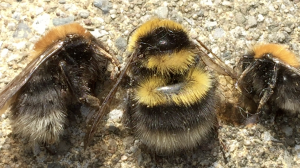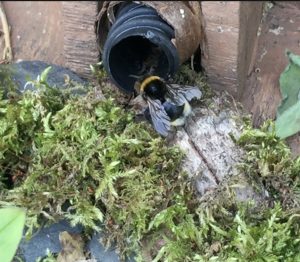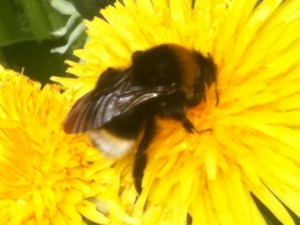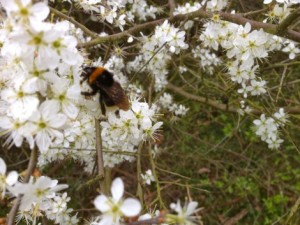Bombus vestalis the lodging cuckoo bee
Initially, the Nurturing Nature nest box was first occupied by a queen Bombus hortorum, in my garden. Little did I know that it was going to be the scene of several crimes, including theft, burglary, deception and possibly murder!
I kept watch over a few days and saw her returning with pollen on her hind legs, implying she had started a nest. I simply left her to it with plans to film once her nest was more established. A few days later I saw a queen B. hypnorum enter the same nest box. She stayed inside and I waited patiently for her to exit. Some considerable time later I was still waiting and decided enough was enough! A case of a possible nest usurpation? A case of murder or was the B. hortorum weak, diseased or simply died of natural causes? Whatever actually happened she died, (see later) and some weeks later this was an active tree bumblebee nest albeit I never saw any dancing drones nor did I see any queens exiting. Did something happen to the B. hypnorum queen which made it impossible for her to produce queens?

Dead B. hypnorum and B. hortorum queens with a B. hypnorum worker all from the same nest box
The Gladiator bumblebee, Bombus vestalis, is a cuckoo bumblebee
Yes, we have all heard of cuckoo birds. Cuckoos and their rather anti-social behaviour are known to many people. But did you know there are species of bees and wasps that are also cuckoos? True queen bumblebees emerging after hibernation may have to fight to the death with other true queen bumblebees in their search for a suitable nest site. The victor we call the foundress queen then sets about establishing her colony. Female cuckoo bumblebees, Psithyrus, specialise in seeking out already established nests.

Bombus vestalis entering an active B. hypnorum nest. Why?
20+ visits by B. vestalis
Let’s assume this was probably the same female Bombus vestalis I filmed. I heard her deep buzzing sound before I saw her and knew what it was. It’s a sound I can now recognise over a true bumblebee queen buzzing sound. It reminds me of a slow-motion helicopter sound! I saw her every day for just over a week. She entered the same nest box several times a day, sometimes stayed for 20 minutes or more. Sometimes so long that I could not wait any longer and had to leave for other ‘duties!’ Other times she spent just a few minutes inside before leaving. With over twenty visits to the same nest box, I was wondering what was happening. She generally flew off in the same direction upon exiting which was over my roof and towards the south. Being the same flight path, I thought she knew where she was going. So much so that I suspected that there may well have been a host-friendly site nearby, within a short distance. In fact the, site I had in mind is only 500 yards or so away as the bee flies, where I previously found 29 B. terrestris queens. The film only shows a few visits to illustrate its actions, which were the same throughout this whole episode, except for one in particular.
Evidence of a fight?
One day B. vestalis came out of the nest box, buzzing slightly, jumping slightly, shaking and vibrating herself with more grooming than usual. Although cuckoo bees are rather slow and lethargic in flight and when crawling, this time she was even slower in her crawling movements. She appeared a little stunned and slow to move, with one of its wings looking out of place, sticking up in the air, if not a little crumpled. I was wondering whether or not it had been fighting with any of the occupants of the nest. This time it flew in a different direction than the usual south flight path. It did though carry on with its visitations to the nest box for a few more days.
Incapable of foundering a nest
Arriving later in the spring than their ‘target’ host species, after feeding up they go in search of a host nest. As they lack wax-producing glands, have fewer hairs on their body to aid pollen collection or to use as a brood patch, nor can they store pollen as do true bumblebees, because of the lack the pollen baskets on their hind legs. They are utterly incapable of foundering a nest themselves. To start a nest, they are wholly dependent upon true bumblebees species and as such are known as an obligate brood parasite. They produce no workers who go out to forage for their siblings, none of her brood participates in tending to the nest as do true worker bumblebees. She produces no queens, only females and males. They are just not equipped to establish their own nests. I would say they are rather lazy in their foraging and flying behaviour and do not have the determination to systematically and efficiently forage from flower to flower as do their diligent hosts. What they lack in nest-foundering ‘equipment’ though, they more than compensate for by having the right ‘equipment’, strategies and single-mindedness to seize and maintain a newly established nest aggressively.
Gladiator bumblebees!
To succeed they are obliged to invade an established nest. They have to fight for a nest site and enslave the resident worker bees already present to feed and tend to her own offspring. These females are born fighters, with their tougher, thicker body armour, which is not as flexible as their hosts, (less chance of being stung in a weak spot). They are equipped with stronger more powerful jaws and stings which have a larger venom sac than do true queen or worker bumblebees. Surely a Gladiator caste of bumblebees!
Wasting pollen
I remember many years ago seeing such a large bumblebee ‘queen’ literally covered in pollen all over her body. She made no attempt to comb it or move it to her pollen baskets. I thought this was rather strange. She sat sunning herself for quite some time. Then she rather lazily started to brush all the pollen from her body onto the ground. I thought what a waste of pollen! Little did I realise as it was only later in life that I found out about cuckoo bumblebees and of course, they do not possess pollen baskets.
Kill or dominate the host queen
When ready, they seek out, by scent and sight, a host nest and either dominate or kill foundress queens, either immediately or at some later stage, along with any adult workers that attack her in defence of their nest. Though when to invade can be a very risky business for the cuckoo bee. Too many workers being present and she will be fiercely attacked by them. During an ensuing fight, some of them may get lucky with their sting and kill the invader. Kill too many workers or invade a nest where there are too few adult workers present, well quite simply, there may not be enough workers to look after and tend her own offspring. Plus she will also have to examine the brood cells to see how many potential host workers there are inside their cells to look after her own offspring, further down the line. As Goulson states, “if they attack a colony before the second batch of workers have been produced they usually prevail”. So timing is critical for her. If she has not already killed the foundress queen she will, in most cases, (some though become submissive) eventually fight with her and in most cases kill her, often killing the host’s eggs and larvae, using the wax cells to make her own. Her ovaries have more branches than a true Bombus queen, so she can lay more eggs in a single batch.
Why was the B. vestalis visiting the B. hypnorum nest?
Bombus vestalis is a specialist cuckoo bee in that is parasitises B. terrestris nests. It is the only known host of Bombus terrestris. There being no B. terrestris nest to invade, what attracted her to the nest site in the first place? Was it the scent and activity that attracted her to the nest? I saw the cuckoo bee enter and leave the nest over twenty times, which for viewing the film can be rather boring! Was it hiding in there, lying low to mask her own scent and to take the scent on from the host nest prior to invading the nest for its own purposes? I strongly suspect something happened to the queen B. hypnorum as the numbers never grew as large as many other such nests I have seen, no queens were produced neither was it invaded by wax moths. Whether or not the cuckoo killed the queen I will never know. Was she simply visiting it and using it as a place of relative safety inside a nest of a non-host species, for lodging and even feeding in there? One thing for certain is that it was not going there for fun!
A place to lodge?
I had searched the internet for goodness know how long with hours spent reading papers and journals. Well, I think I have found the answer, good ol’ Sladen to the rescue! “In her wanderings, the Psithyrus may find and enter the nest of some other species of Bombus. Having succeeded in making herself acceptable to the inhabitants, she becomes a temporary lodger in this nest, making it her headquarters and returning to it for meals and also to pass the night.” To me, this sounds absolutely plausible. What do you think?
A cunning strategy
Of course by using the relative safety of another bumblebees nest box, she was sheltered from the weather, unwittingly protected by her hosts, had an ample supply of food and as each day went by, she could increase her chances of not having to waste time inside her host’s nest evading an attack and could far sooner lay her own eggs much earlier than a ‘normal’ invasion. On the other hand, her potential host may not yet have produced enough workers, so she bided her time and only left her ‘lodgings’ when her potential host had enough workers to sustain the cuckoo bees offspring.
Cleaning the nest out and questions
When I was cleaning the nest out, I found a queen B. hortorum dead inside the bottom front facing air vent, near the nest entrance. Had she crawled there to escape when the B. hypnorum queen came and was then killed by her or did she try to escape, could not because of the metal vent and died there? Why did the queen B. hypnorum die? I did check a few times and never saw her, with only workers present. Why were no queens or males produced from this nest?

Cuckoo bumblebee, B. vestalis feeding upon a dandelion

B. vestalis feeding on blackthorn 30 March 2012
If you want to find a B. vestalis in spring, check out dandelion and blackthorn flowers. They are rather lazy and clumsy bees and tend to forage on flowers that they can reach easily without having to fly. Both of these plants are ideal for them.
With thanks to Steven Falk for confirming my identification of the B. vestalis.
Refs and interesting resources
Besides my own knowledge and observations:
Alford, D V (2009) “The life of the Bumblebee”, Northern Bee Books, Hebden Bridge, West Yorks
Goulson, D (2010) “Bumblebees” Oxford University Press
Prys-Jones, O.E. and Corbet, S.A. (1991) Bumblebees. Naturalists’ Handbooks 6. Richmond Publishing Co. Ltd, Slough.
Sladen, F W L “The Humble Bee”
For info and link to buy an excellent book Field Guide to the Bees of Great Britain and Ireland by Steven Falk with an extremely useful resource supports this book with a special website feature within Steve Falk’s Flickr website which furnishes extra photos and other useful resources to assist with identification.
Bombus vestalis photos by Steven Falk
Interested in Citizen Science and pollinators? See The Buzz Club.
You may find this paper interesting about the role of scents used by cuckoo Psithyrus bumblebees
See female B.vestalis feeding up before hibernation
See female B. vestalis checking out potential host nest site
Thanks to Steven Falk for confirmation ID of B. vestalis
“I hope you enjoyed this film and article finding it interesting and useful. All my articles and videos, available free, are funded by my teaching and sales of my award-winning bumblebee nest boxes, solitary bee nest boxes, peanut bird feeders and other wildlife gardening products. Please help by spreading the word and forwarding this link to your friends and colleagues. https://nurturing-nature.co.uk Thank you.” George Pilkington

Recent Comments